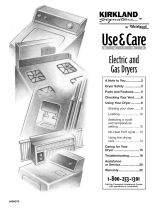Whirlpool TGDL600W User manual
- Category
- Tumble dryers
- Type
- User manual
This manual is also suitable for
Whirlpool TGDL600W is an automatic dryer, designed to dry clothes and other fabrics quickly and efficiently. It features several automatic cycles, including Auto-Sense Heavy, Auto-Sense Permanent Press, and Damp Dry, which allow you to select the right drying level for your clothes. Additionally, it has a Wrinkle Free cycle that helps to remove wrinkles from clothes that have been packed or not removed promptly from the dryer. The No Heat/Fluff cycle is designed for drying heat-sensitive fabrics such as rubber and plastic.
Whirlpool TGDL600W is an automatic dryer, designed to dry clothes and other fabrics quickly and efficiently. It features several automatic cycles, including Auto-Sense Heavy, Auto-Sense Permanent Press, and Damp Dry, which allow you to select the right drying level for your clothes. Additionally, it has a Wrinkle Free cycle that helps to remove wrinkles from clothes that have been packed or not removed promptly from the dryer. The No Heat/Fluff cycle is designed for drying heat-sensitive fabrics such as rubber and plastic.












-
 1
1
-
 2
2
-
 3
3
-
 4
4
-
 5
5
-
 6
6
-
 7
7
-
 8
8
-
 9
9
-
 10
10
-
 11
11
-
 12
12
Whirlpool TGDL600W User manual
- Category
- Tumble dryers
- Type
- User manual
- This manual is also suitable for
Whirlpool TGDL600W is an automatic dryer, designed to dry clothes and other fabrics quickly and efficiently. It features several automatic cycles, including Auto-Sense Heavy, Auto-Sense Permanent Press, and Damp Dry, which allow you to select the right drying level for your clothes. Additionally, it has a Wrinkle Free cycle that helps to remove wrinkles from clothes that have been packed or not removed promptly from the dryer. The No Heat/Fluff cycle is designed for drying heat-sensitive fabrics such as rubber and plastic.
Ask a question and I''ll find the answer in the document
Finding information in a document is now easier with AI
Related papers
-
Whirlpool COMPACT DRYERS User manual
-
Whirlpool 3401011 User manual
-
Whirlpool ELECTRIC AND GAS DRYERS User manual
-
Whirlpool LTE5243BN0 Owner's manual
-
Whirlpool LER5848DQ0 User manual
-
Whirlpool 3401092 User manual
-
Whirlpool TEDL640DQ0 User manual
-
Whirlpool 3396311 User manual
-
Whirlpool Thin Twin User guide
-
Whirlpool Roper REL3612BW2 User manual
Other documents
-
Estate TEDL400AW0 User manual
-
Estate 3401085 User guide
-
Estate Clothes Dryer User guide
-
Roper Dryer User guide
-
Roper RGS7646KQ2 Owner's manual
-
Estate 8318478A User manual
-
KitchenAid KEYW777B User manual
-
 Kirkland Signature 3406079 User manual
Kirkland Signature 3406079 User manual
-
General Electric DDE7607M User manual
-
KitchenAid KGYE664W User manual












